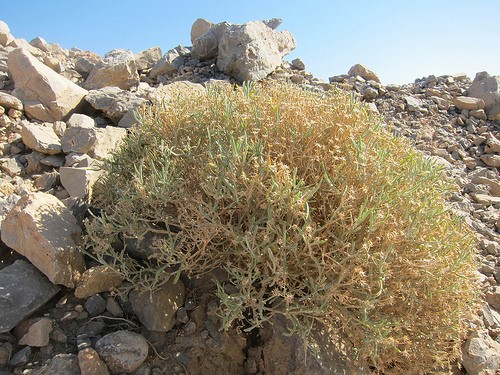
Pulicaria edmondsonii / اشنات
Shnat
Shnat
Asteraceae
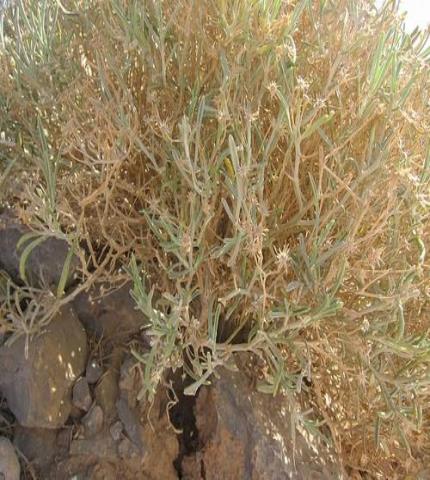
Aerial parts
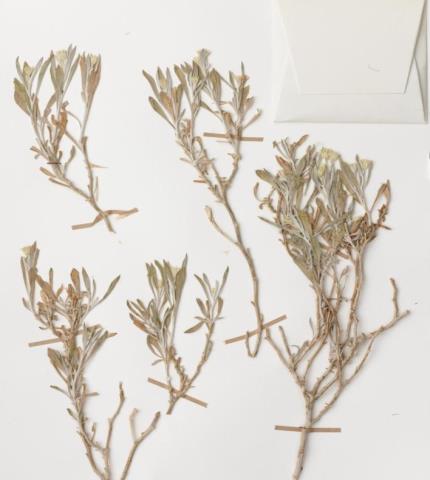
Herbarium specimen
Ethnobotanical Characteristics
Description
The plants are perennial with a stem that branches profusely from the base, erect, up to 30 cm. Stems and leaves silvery-green. Leaves are narrow, linear, 0.2 x 1 cm. Flower heads yellow, terminal, 0.5 x 1cm. Flowering Feb-Apr. (Jongbloed, 2003).
Habitat and Distribution
Usually found in hillsides and locally abundant in the Hajar mountains and Ru’us al-Jibal.
Pharmacognosy and Phytochemistry
General appearance
The leaves are grayish-brown, and narrowing lanceolate or circular, petiolate with entire margins. The length is variable, but it can attain more than 55 mm and about 3 mm in breadth. It curls slightly inwards, leaving the lower epidermis outwards. It is brittle and can break easily.
Microscopic characteristics
A surface view of the leaf shows that it is densely covered with very long slender covering trichomes on both surfaces. A transverse section through the leaf shows that both upper and lower epidermises consists of small oval cells covered with striated cuticle; epidermal cells at the margins seem to be almost rounded in shape. The leaf is dorsoventral, and the only palisade layer is underlying the upper epidermis. It consists of short, broad cells with thin walls, and they are rich in rounded coloured materials. The spongy cells occupy a large portion of the mesophyll, and they consist of small rounded and polygonal cells, and most of them contain amorphous masses; the presence of these amorphous masses is quite characteristic for the leaf. The spongy mesophyll cells that surround the vascular tissues have distinct thick cell walls and they are polygonal in shape.
Plant material used
Dried stem and branches
General appearance
The stem and branches are silvery-white in colour and woolly in touch, but the epidermis and other adjacent cortical tissues are partially removed, exhibiting a light yellow longitudinally striated bark. Branches are about 3 mm in diameter, have many internodes and they are brittle.
Microscopic characteristics
A surface view of the branch shows that the epidermis is consisting of polygonal, almost rectangular cells. The epidermis is densely covered with slender long covering trichomes similar to those found on the leaf. A transverse section of the stem shows that it is not quite cylindrical in outline; rather, it has peripheral protrusions of arches. In transverse section, the epidermal cells have oval or oblong shapes. The epidermis layer is underlain by few rounded and polygonal cortical parenchyma cells that are rich in yellow-coloured rounded materials. Underneath there are about six layers of cortical collenchymas cells that are interrupted by characteristic groups of heavily lignified fibers and accompanying pitted parenchyma cells. These surround vascular tissues whose xylem tissues, including vessels, fibers, and pitted parenchyma are heavily lignified. The pith is composed of many polygonal moderately lignified parenchyma cells with pitted cell walls.
Parts studied
leaf and stem

A) Upper epidermis of leaf

B) TS of leaf
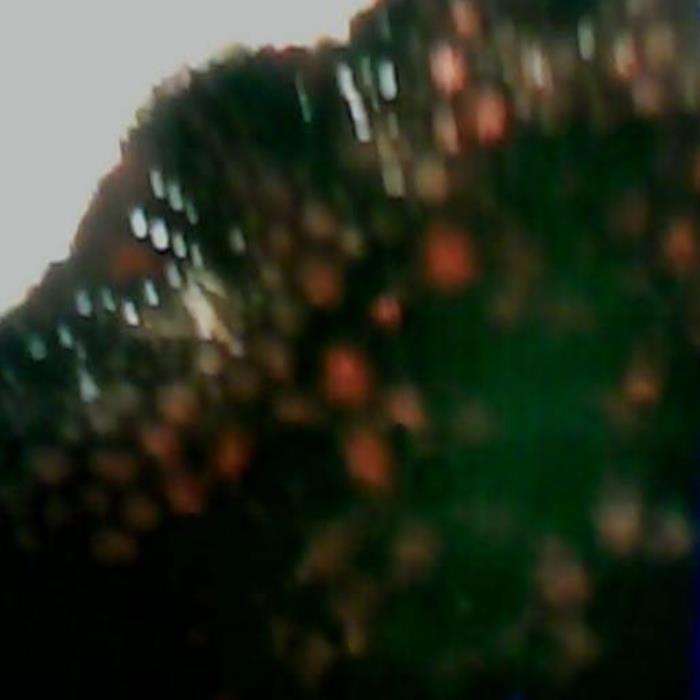
C) TS of stem
- A. A surface view of a portion of the upper epidermis of the leaf showing that it is obscured by numerous very long slender covering trichomes.
- B. A TS of the leaf at the midrib region showing the upper epidermis covered with a striated cuticle underlain by a palisade layer consisting of short broad cells rich in rounded colored materials then the sponge mesophyll tissues that contain amorphous masses (dark in colour). The broad dark area near the centre consists of vascular tissues.
- C. TS of the stem at the vascular tissues zone showing the pattern of their lignification.
Chemical constituents
No chemical compounds for this plant have been reported in the literature. Flavonoids and steroids (qualitative) along with Isobornyl acetate, tetra acontane, oleic acid, beta sitosterol, stigma sterol and betulin (GC-MS &TLC) were identified in the methanolic extract of the plant (ZCHRTM unpublished work).
The following chemical studies have been carried out on the plant Pulicaria edmondsonii (Quality Control methods, 1998; Evans, 1996; ZCHRTM unpublished work)
Physicochemical constituents
Loss of weight in drying at 105°C : 9.10
Absolute alcohol solubility : 2.00
Water solubility : 28.00
Successive extractives (%)
Petroleum ether (60-80) °C : 1.45
Chloroform : 1.10
Absolute alcohol : 7.25
Ash values (%)
Total ash : 19.17
Water soluble ash : 6.50
Acid insoluble ash (10% HCl) : 1.34
pH values (aqueous solution)
pH of 1% solution : 6.33-6.35
pH of 10% solution : 5.82-5.83
Elemental analyses
Ash values (British Herbal Pharmacopeia)
Assay and identification of element (AOAC international)
|
Apparatus |
AA-6800 Shimadzu- Flame method |
||||
| Element | Std. conc. µg/ml ppm) | Sample conc.mg/ml | Sample absorbance | Actual conc.mg/ml | Actual conc. (%) |
|
Cr |
1, 2, 4 |
20 |
0.0091 |
0.0089050 |
0.0008905 |
|
Zn |
0.25, 0.5, 1 |
20 |
0.5752 |
0.028055 |
0.0028055 |
|
Cu |
1, 2, 4 |
20 |
0.0355 |
0.01003 |
0.001003 |
|
Fe |
1, 2, 4 |
20 |
0.3362 |
0.141515 |
0.0141515 |
|
K |
1, 2, 4 |
1 |
1.0126 |
9.1124004 |
0.91124004 |
|
Pb |
1, 2, 4 |
20 |
0.0022 |
0.00331 |
0.000331 |
|
Cd |
0.25, 0.5, 1 |
20 |
0.0056 |
0.00026 |
0.000026 |
|
Ca |
5, 10, 20 |
1 |
0.0479 |
8.9860996 |
0.89860996 |
| 1ppm conc. = 1µg/ml; Actual conc. (%) =Actual conc.(ppm)x0.0001 [1ppm=0.0001%] | |||||
UV Spectral studies
|
Ultraviolet Spectrum (USP) |
||||
|
Apparatus |
Milton Roy Spectronic Genesys 5 Spectrophotometer - Milton Roy. |
|||
|
Sample conc. (mg / ml) |
Solvent |
λ max (nm) |
λ min (nm) |
Abs.( λ max - λ min) |
|
1.01 |
Intestinal Fluid simulated without pancreatic pH=7.50.1 |
271 |
257 |
0.547 - 0.520 |
|
1.13 |
Gastric Fluid simulated without pepsin pH =1.20.1 |
268 325 |
313 |
1.075 - 0.815 0.824 |
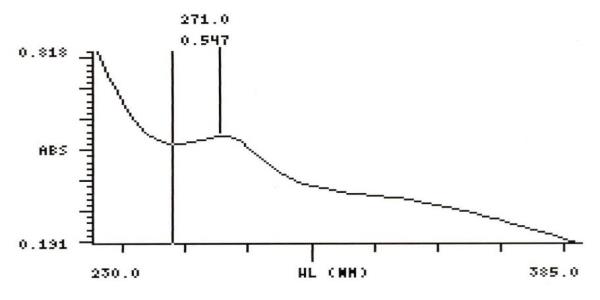
Intestinal Fluid simulated without pancreatic
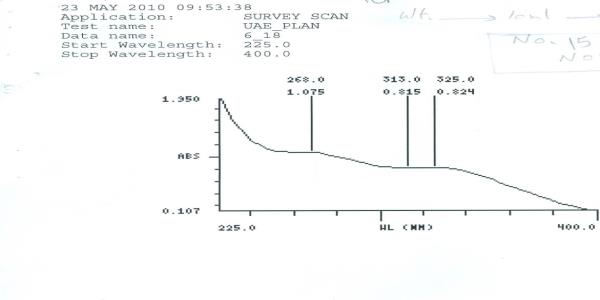
Gastric Fluid simulated without pepsin
Chromatographical Studies
Thin layer chromatography (TLC): Wagner and Bladt, 1996

A

B

C

D
TLC fingerprint of Petroleum ether 60-80°C (track 1) and MeOH extract (track 2)
|
Mobile phase Fig. |
A&B |
: |
Ethyl acetate, methanol, water (100:13.5:10) |
|
|
C |
: |
Toluene, ethyl acetate (93:7) |
|
|
D |
: |
Toluene, ethyl formate, formic acid (5:4:1) |
|
Detection |
A |
: |
UV 254nm |
|
|
B |
: |
UV 366nm |
|
Derivatization |
C&D |
: |
Vanillin-Sulphuric acid- vis. |
Pharmacological and toxicological studies
The following summary is based on published research:
The immuno-stimulatory effects of methanol extract from Pulicaria crispa were investigated in mice before and after infection with Schistosoma mansoni. A significant increase in IgG levels in sera from the extract-treated mice before and after infection (Maghraby, 2010). Two major constituents were isolated and identified as 2-isopropyl-4-methylphenol (1) and isobutyric acid 2-isopropyl-4-methylphenylester (2), the isolated compounds are reported for the first time from Pulicaria genus. The essential oils exhibited a very significant antibacterial and antifungal activity, while the isobutyric acid 2-isopropyl-4-methylphenylester (2) was inactive for all tested strains (Ezoubeiri, 2005). An ethnobotanical review of the uses of plants led us to the investigation of some edible and wound-healing herbs for antioxidant activity. Of the 19 plants investigated, the aqueous ethanol extract of Pulicaria crispa, showed inhibition of DPPH free radicals at 89-93%, after 15 min of incubation at a test concentration of 50 ug/ml. (Marwah, 2007)
The following pharmacological and safety evaluation studies were carried out on the plant Pulicaria edmondsonii using 70% alcoholic extract (Derelanko 2002; Han, 2003).
|
ACTIVITY |
RESULTS |
|||
|
Strong |
Moderate |
Mild |
Negative |
|
|
Anti-diabetic activity (STZ mice) |
|
|
√ |
|
|
Antidepressant activity (TST) |
|
|
|
√ |
|
Anti-inflammatory effect |
√ |
|
|
|
|
Effect on rabbit jejunum |
|
√ |
|
|
|
Effect on rabbit corpus cavernous strip |
|
|
√ |
|
|
Effect on Guinea pig tracheal chain |
|
√ |
|
|
|
Acute toxicity |
|
|
|
√ |
|
Autonomic effect |
|
|
√ |
|
|
Rectal temperature ↑ |
√ |
|
|
|
|
Locomotor activity test |
|
|
√ |
|
|
Motor co-ordination (Rota Rod) ↑ |
√ |
|
|
|
|
Body weight |
|
|
|
√ |
|
Mortality |
|
|
|
√ |
Summary of results
The plant extract possesses mild anti-hyperglycemic activity. The extract also showed increased spontaneous activity in rabbit jejunum, and the rabbit corpus cavernous strip showed marked relaxation. There was a significant anti-inflammatory, bronchiodilatory, anti-allergenic, and anti-asthmatic activity in guinea-pig tracheal chains. The plant extract considered safe at the dose tested and there was no death of animals.
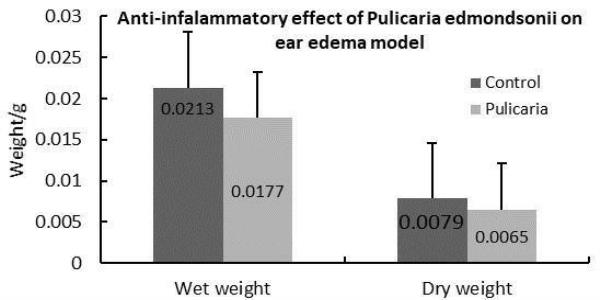
Anti-inflammatory effect on ear edema model
Antimicrobial activity
The aqueous extract of the whole plant was tested against Mycobacterium smegmatis, C. tropicalis, different strains of Staphylococcus aureus (Including ATCC 257), strains of Methicillin-Resistant Staphylococcus aureus, strains of Streptococcus pyogenes, strains of E. coli (Including ATCC UN 109), different strains of ESBL-producing K. pneumonia, E. coli, Pseudomonas aeruginosa. The extract showed potent antibacterial activity against S. aureus, S. pyogenes and M. smegmatis.
References
- Ezoubeiri, C.A. Gadhi, N. Fdil, A. Benharref, M. Jana and M. Vanhaelen Isolation and antimicrobial activity of two phenolic compounds from Pulicaria odora L. Journal of Ethnopharmacology Vol. 99, June 2005, 2,3 : 287-292 .
- Jonbloed, M. V., Feulner, G. R., Boer, B. & Western, A. R. (2003). The comprehensive Guide to the Wild Flowers of the United Arab Emirates, Erwda, Abu Dhabi, U.A.E.
- Maghraby AS, Shalaby N, Abd-Alla HI, Ahmed SA, Khaled HM, Bahgat MM. Immunostimulatory effects of extract of Pulicaria crispa before and after Schistosoma mansoni infection. Acta Pol Pharm. Jan-Feb 2010; 67:75-9.
- Marwah R.G.,Fatope M.O.,Mahrooqi R.A.,Varma G.B.,Abadi H.A.,Al-urtamani S.K.S. Antioxidant capacity of some edible and wound healing plants in Oman, Food Chemistry, vol./is. 2007, 101/2(465-470), 0308-8146 (2007)
- Western, A. R. (1986). The Flora of United Arab Emirates. An introduction. –Al Ain.
- Western, A. R. (1989). The Flora of United Arab Emirates. An introduction. Publications of the U.A.E. University.
